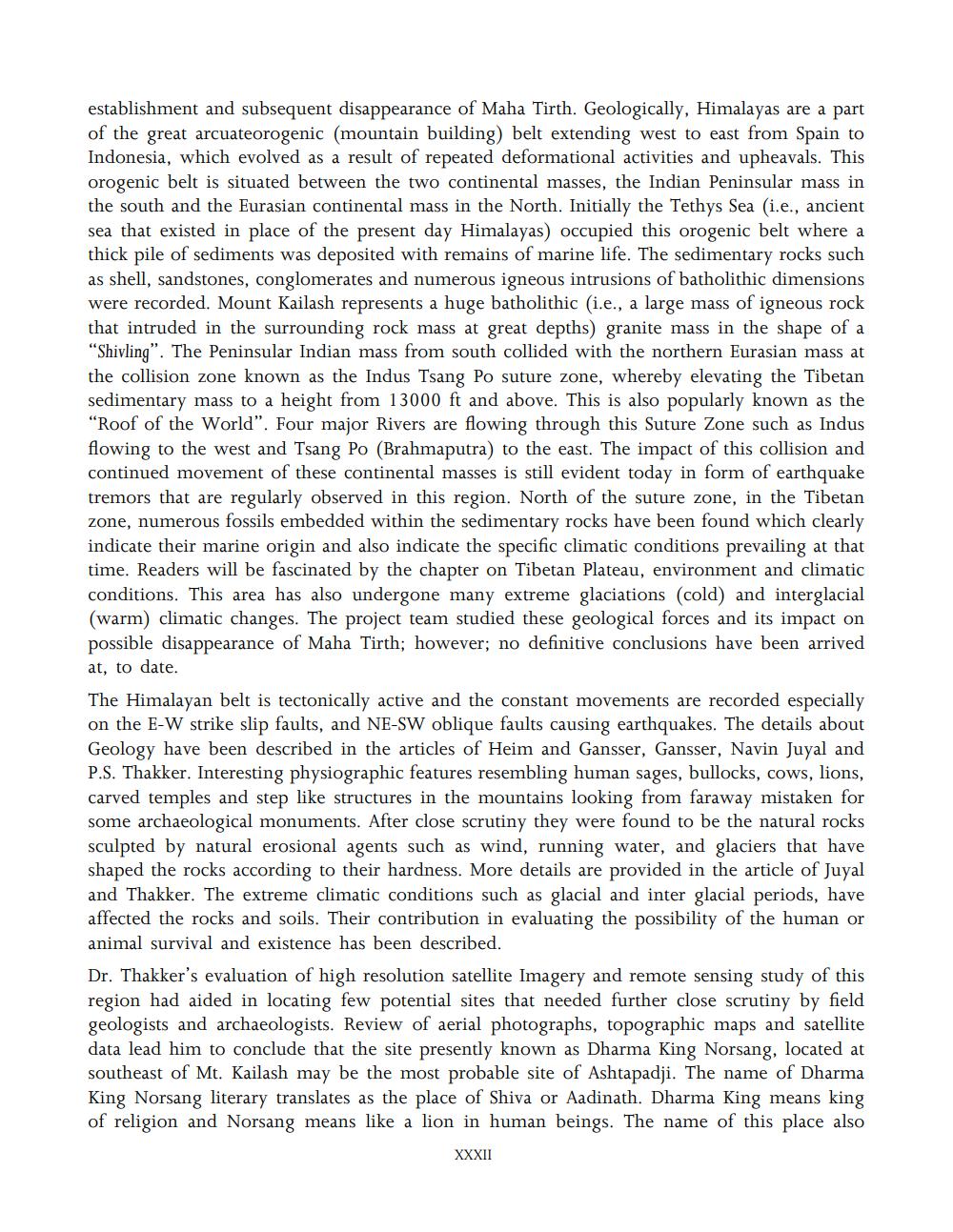________________
establishment and subsequent disappearance of Maha Tirth. Geologically, Himalayas are a part of the great arcuateorogenic (mountain building) belt extending west to east from Spain to Indonesia, which evolved as a result of repeated deformational activities and upheavals. This orogenic belt is situated between the two continental masses, the Indian Peninsular mass in the south and the Eurasian continental mass in the North. Initially the Tethys Sea (i.e., ancient sea that existed in place of the present day Himalayas) occupied this orogenic belt where a thick pile of sediments was deposited with remains of marine life. The sedimentary rocks such as shell, sandstones, conglomerates and numerous igneous intrusions of batholithic dimensions were recorded. Mount Kailash represents a huge batholithic (i.e., a large mass of igneous rock that intruded in the surrounding rock mass at great depths) granite mass in the shape of a "Shivling”. The Peninsular Indian mass from south collided with the northern Eurasian mass at the collision zone known as the Indus Tsang Po suture zone, whereby elevating the Tibetan sedimentary mass to a height from 13000 ft and above. This is also popularly known as the “Roof of the World”. Four major Rivers are flowing through this Suture Zone such as Indus flowing to the west and Tsang Po (Brahmaputra) to the east. The impact of this collision and continued movement of these continental masses is still evident today in form of earthquake tremors that are regularly observed in this region. North of the suture zone, in the Tibetan zone, numerous fossils embedded within the sedimentary rocks have been found which clearly indicate their marine origin and also indicate the specific climatic conditions prevailing at that time. Readers will be fascinated by the chapter on Tibetan Plateau, environment and climatic conditions. This area has also undergone many extreme glaciations (cold) and interglacial (warm) climatic changes. The project team studied these geological forces and its impact on possible disappearance of Maha Tirth; however; no definitive conclusions have been arrived at, to date. The Himalayan belt is tectonically active and the constant movements are recorded especially on the E-W strike slip faults, and NE-SW oblique faults causing earthquakes. The details about Geology have been described in the articles of Heim and Gansser, Gansser, Navin Juyal and P.S. Thakker. Interesting physiographic features resembling human sages, bullocks, cows, lions, carved temples and step like structures in the mountains looking from faraway mistaken for some archaeological monuments. After close scrutiny they were found to be the natural rocks sculpted by natural erosional agents such as wind, running water, and glaciers that have shaped the rocks according to their hardness. More details are provided in the article of Juyal and Thakker. The extreme climatic conditions such as glacial and inter glacial periods, have affected the rocks and soils. Their contribution in evaluating the possibility of the human or animal survival and existence has been described. Dr. Thakker's evaluation of high resolution satellite Imagery and remote sensing study of this region had aided in locating few potential sites that needed further close scrutiny by field geologists and archaeologists. Review of aerial photographs, topographic maps and satellite data lead him to conclude that the site presently known as Dharma King Norsang, located at southeast of Mt. Kailash may be the most probable site of Ashtapadji. The name of Dharma King Norsang literary translates as the place of Shiva or Aadinath. Dharma King means king of religion and Norsang means like a lion in human beings. The name of this place also
XXXII




